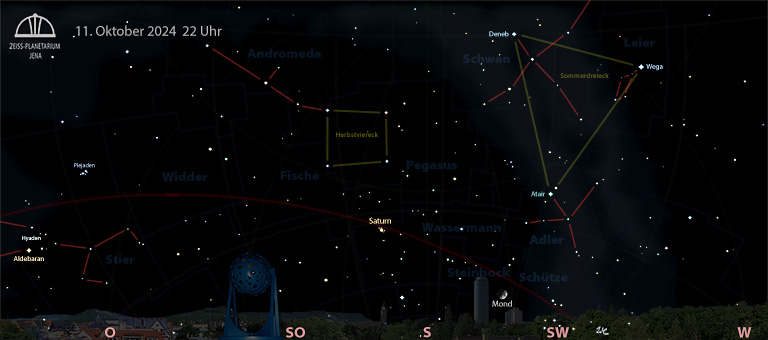4 Planeten am Abend und Zeitumstellung
Die mittägliche Sonnenhöhe verringert sich von 35 Grad bis zum Monatsende auf 25 Grad, damit auch die Länge des hellen Tages auf weniger als 10 Stunden. Am 31. verlässt die Sonne das Tierkreissternbild Jungfrau und zieht vor die Waage.
Am 27. Oktober endet die Mitteleuropäische Sommerzeit 2024 in Deutschland. Die Uhren werden von 3 Uhr auf 2 Uhr zurückgestellt.
Neumond ist am 2. Oktober, Vollmond ist am 17.
Unser innerer Nachbarplanet Venus ist in der Dämmerung am Südwesthorizont zu finden. Am frühen Abend ist in südlicher Richtung der Ringplanet Saturn vor dem Tierkreissternbild Wassermann und in nordöstlicher Richtung der Riesenplaneten Jupiter vor dem Tierkreissternbild Stier zu sehen. Kurz vor Mitternacht erscheint im Nordosten unser äußerer Nachbarplanet Mars am Horizont.
Die frühen Nachtstunden dokumentieren den Abschied vom Sommer, das Sommerdreieck ist bereits im Südwesten zu finden. Der Deneb im Sternbild Schwan, die Wega in der Leier – beide stehen sehr hoch – und der Atair unten bilden dieses gleichschenklige Dreieck. Südlich folgen die weniger hellen Sterne des Herbstvierecks, das aus Sternen der Sternbilder Pegasus und Andromeda besteht. Deren Sternkette weist in den Osten.
In den späteren Nachtstunden bis in den Morgen zeigen sich im Südosten bereits die Sterne des Wintersechsecks. Auffällig sind der Himmelsjäger Orion und der helle funkelnde Sirius im Großen Hund. Im Stier können wir zwei offenen Sternhaufen entdecken, die Plejaden oder Siebengestirn und die Hyaden oder Regengestirn. Der rötliche Aldebaran gehört ebenso zum Wintersechseck wie Kapella hoch darüber, die Zwillinge Kastor und Pollux auf der östlichen Seite sowie Prokyon im Kleinen Hund, Sirius im Großen Hund und Rigel im Orion.
W. Don Eck
Zeiss-Planetarium Jena
The starry sky in October 2024
4 planets in the evening and time changeover
The midday altitude of the sun decreases from 35 degrees to 25 degrees by the end of the month, reducing the length of the light day to less than 10 hours. On the 31st, the sun leaves the zodiacal constellation of Virgo and moves in front of Libra. 27 October marks the end of Central European Summer Time 2024 in Germany. The clocks are set back from 3 a.m. to 2 a.m. The new moon is on 2 October and the full moon is on 17 October. Our inner neighbouring planet Venus can be found on the south-western horizon at dusk. In the early evening, the ringed planet Saturn can be seen in a southerly direction in front of the zodiacal constellation Aquarius and the giant planet Jupiter can be seen in a north-easterly direction in front of the zodiacal constellation Taurus. Shortly before midnight, our outer neighbouring planet Mars appears on the horizon in the north-east.
The early hours of the night document the farewell to summer, the summer triangle can already be found in the south-west. Deneb in the constellation Swan, Vega in Lyra – both very high – and Atair below form this isosceles triangle. To the south follow the less bright stars of the autumn quadrilateral, which consists of stars from the constellations Pegasus and Andromeda. In the later hours of the night and into the morning, the stars of the winter hexagon can already be seen in the south-east. The sky hunter Orion and the bright, twinkling Sirius in the Great Dog are conspicuous. In Taurus we can discover two open star clusters, the Pleiades and the Hyades or Rainy Stars. The reddish Aldebaran is also part of the winter hexagon, as are Capella high above it, the twins Castor and Pollux on the eastern side and Prokyon in the Little Dog, Sirius in the Great Dog and Rigel in Orion.



